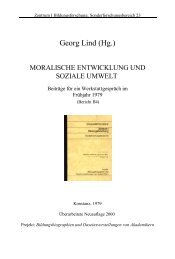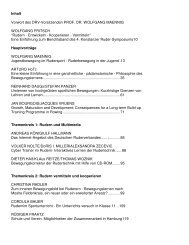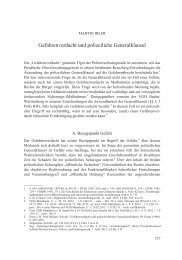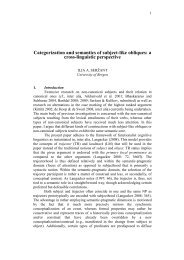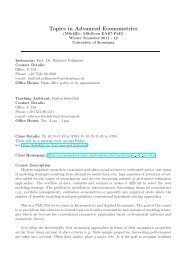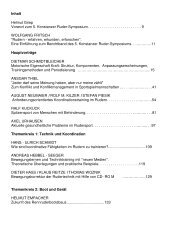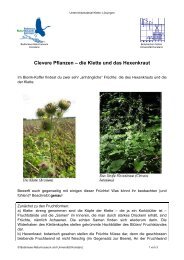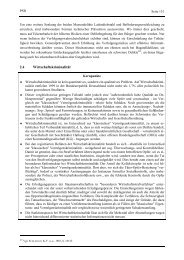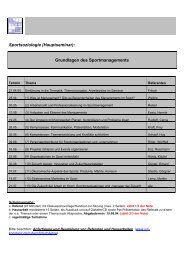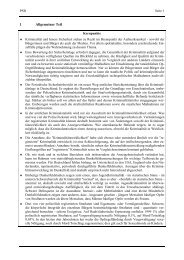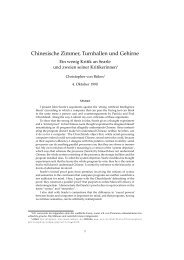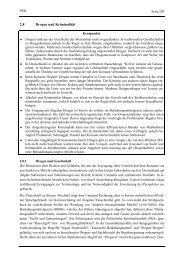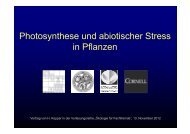Book of Abstracts Book of Abstracts - Universität Konstanz
Book of Abstracts Book of Abstracts - Universität Konstanz
Book of Abstracts Book of Abstracts - Universität Konstanz
You also want an ePaper? Increase the reach of your titles
YUMPU automatically turns print PDFs into web optimized ePapers that Google loves.
B - 17<br />
Probing Strong Hydrogen Bonds and Cold Metal Oxide Clusters with<br />
Infrared Photodissociation Spectroscopy<br />
Knut R. Asmis<br />
Abteilung Molekülphysik, Fritz-Haber-Institut der Max-Planck-Gesellschaft<br />
Faradayweg 4-6, D 14195 Berlin<br />
In recent years much effort has been aimed at improving the sensitivity and selectivity <strong>of</strong><br />
experimental methods to study the vibrational spectroscopy <strong>of</strong> gas phase ions. Due to the lack <strong>of</strong><br />
widely tunable infrared (IR) light sources most <strong>of</strong> these studies had been limited to the region<br />
above 2400 cm -1 , i.e., the spectral region <strong>of</strong> hydrogen-stretching motions and <strong>of</strong> IR-active<br />
combination bands. The application <strong>of</strong> the infrared free-electron laser FELIX, which generates<br />
tunable radiation in the 40 – 2200 cm -1 region, to molecular spectroscopy by Meijer, von Helden<br />
and coworkers has bridged this gap [1]. We have recently extended their technique to study the<br />
vibrational spectroscopy <strong>of</strong> mass-selected gas-phase cluster cations and anions at variable<br />
temperature. Application <strong>of</strong> this technique to two important compound classes will be discussed<br />
and compared to the results <strong>of</strong> complimentary experiments on mass-selected neutral clusters<br />
using femtosecond pump-probe spectroscopy.<br />
The hydrogen bond interaction is key to understanding the structure and properties <strong>of</strong> water<br />
and biomolecules. However, our understanding <strong>of</strong> strong, low-barrier hydrogen bonds and their<br />
central role in enzyme catalysis, biomolecular recognition, proton transfer across biomembranes<br />
and proton transport in aqueous media remains sketchy. We recently measured the first IR<br />
spectra <strong>of</strong> several prototypical systems, directly probing the shared proton region <strong>of</strong> the<br />
potential energy surface [2,3]. Our experiments demonstrate that the theoretical description <strong>of</strong><br />
the vibrations <strong>of</strong> strong hydrogen bonds is considerably more complex than originally<br />
anticipated and not yet solved satisfactorily, even for small systems and at the highest levels <strong>of</strong><br />
theory currently available.<br />
Transition metal oxides play an increasingly important role in heterogeneous catalysis.<br />
Recent gas-phase reactivity studies on vanadium oxide cluster ions were aimed at understanding<br />
the nature <strong>of</strong> the reactive sites. The interpretation <strong>of</strong> the reactivity data requires information on<br />
the structure <strong>of</strong> the cluster ions. We employ IR photodissociation spectroscopy in combination<br />
with electronic structure calculations to identify the geometric structure as well as structural<br />
trends as a function <strong>of</strong> cluster size in vanadium oxide cluster cations and anions [4]. For the<br />
cluster anions we present the first experimental evidence for the formation <strong>of</strong> polyhedral<br />
vanadium oxide cages in the gas phase. The measured IR spectra are sensitive probes for charge<br />
localization <strong>of</strong> unpaired d-electrons and show a strong resemblance with the IR spectrum <strong>of</strong> a<br />
V2O5 surface already at medium cluster sizes.<br />
References<br />
[1] G. von Helden, I. Holleman, G. M. H. Knippels, A. F. G. van der Meer, and G. Meijer, Phys. Rev.<br />
Lett. 79, 5234 (1997).<br />
[2] K. R. Asmis, N. L. Pivonka, G. Santambrogio, M. Brümmer, C. Kaposta, D. M. Neumark, and L.<br />
Wöste, Science 299, 1375 (2003).<br />
[3] M. Nee, C. Kaposta, A. Osterwalder, C. Cibrian Uhalte, T. Xie, A. Kaledin, S. Carter, J. M.<br />
Bowman, G. Meijer, D. M. Neumark, and K. R. Asmis, J. Chem. Phys. 121, 7259 (2004).<br />
[4] K. R. Asmis, G. Meijer, M. Brümmer, C. Kaposta, G. Santambrogio, L. Wöste, and J. Sauer, J.<br />
Chem. Phys. 120, 6461 (2004).<br />
55



